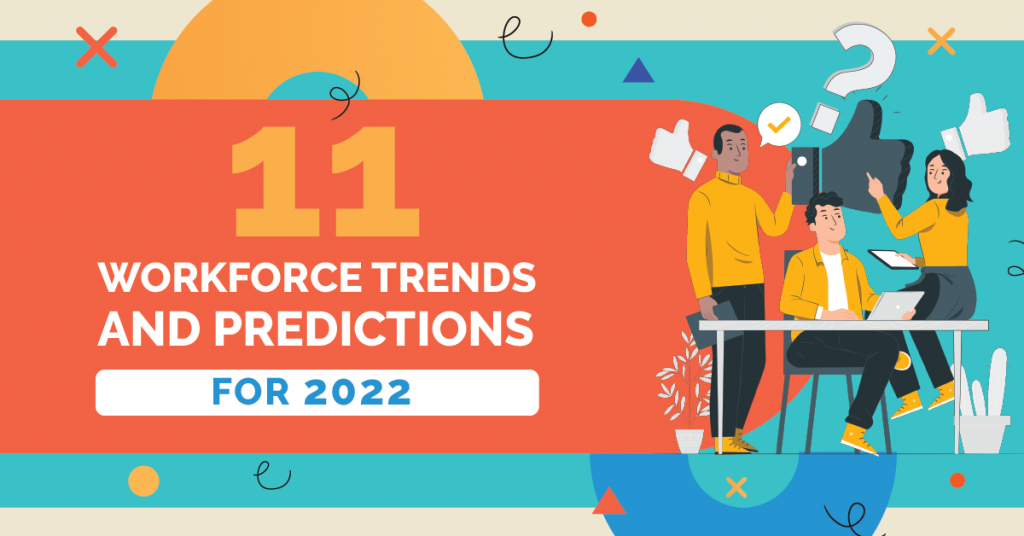
Change is constant. That’s something you can place your bet on. And it applies to all aspects of life, including the workplace.
There are a couple of reasons for what triggers change. First, there’s the advent of new technologies. For instance, collaboration software such as Trello and Slack allows teams to work remotely with ease and convenience.
Second, there are the ever-shifting employee expectations. These days, you can’t expect your employees to hold on to their job merely for the sake of having a job. In fact, there’s a trend recently observed called the great resignation, wherein workers choose to ditch their bread and butter, prompted mostly by dissatisfaction and perhaps the belief that there are greener pastures.
To be spared from the effects of the great resignation, it’s high time you abandon obsolete workplace practices in favor of new and more favorable approaches. In this infographic, we give a rundown of workforce trends to expect for the year 2022.

11 Workforce Trends and Predictions for 2022
1. More Gen Z employees in the workforce
Born between 1997 and early 2010, the oldest member of Gen Z is now 23 years old and ready to join the labor force. In fact, the 2021 job trends prognosis had it that Gen Z will make up 40% of the global workforce. Whether that prediction held water is out of the question. What matters is recognizing that there is something to gain from this latest inclusion in the workplace generational mix.
Gen Z will offer a fresh perspective to established teams comprised of boomers, Gen X-ers, and millennials. It’s also worth noting that they are comfortable with technology, being born in the digital age surrounded by gadgets.
2. Hybrid work is here to stay
The pandemic had caused offices to shut down for indefinite periods. Now that we’re on the tail-end of a global health catastrophe thanks to aggressive inoculation efforts worldwide, more and more employees will have to show up at the office again. That does not mean remote work will fall out of fashion. What will likely happen is the introduction of hybrid work.
About 80% of employees want to switch to a hybrid work setup even after the pandemic. Hybrid work could mean dividing teams into offices and remote workers, depending on personal preferences and a job’s flexibility to a specific work arrangement. An even better approach is allowing employees to navigate between the office and remote setups with reliance on personal judgment.
3. Companies will struggle to recover from the Great Resignation
In September 2021, 4.4 Americans left their jobs. Dubbed as the Great Resignation, this trend won’t relent anytime soon. One possible reason is how the pandemic has triggered people to reassess their priorities. Family time and well-being are now more of a priority, and employees are willing to leave their jobs for companies that can offer those.
For businesses, this trend poses real challenges. Labor gaps will have to be filled, and hiring best practices must get more competitive.
4. More emphasis on worker retention
With the great resignation at play, 87% of HR professionals see worker retention as the top priority in the next five years. Employers need to be more aggressive with their worker retention efforts as the turnover cost is, well, costly: a resignee’s financial burden to employers can reach up to 33% of an employee’s annual salary.
With that in mind, it’s better to do everything in your power to convince workers to stay. One way to do that is by offering attractive remuneration packages. It also won’t hurt to conduct “stay interviews” to get a feel of a worker’s experience. In these one-on-one sessions, your goal is to be on the same page with an employee whom you suspect is on the verge of calling it quits.
5. More investment in employee upskilling
Another reason employees leave is the lack of a clear career pathway within an organization, with 70% leaving for a company that offers better development and training. If they feel that they are not getting the training and development necessary to advance their position in the company, they’ll likely look elsewhere. This is where upskilling comes in.
The benefit of upskilling is two-fold. The first is employee productivity. After all, skilled employees have more to bring to the table. The second is a positive employee experience, which, in turn, supports retention goals.
6. Tapping more alumni talent
Do not burn bridges, they say. And that’s pretty good advice. While it mainly applies to personal lives. It’s high time for businesses to implement this piece of wisdom into HR practices, too. Sometimes, it can’t be helped; you lose top-notch talents. But that does not mean they’ll be out of reach for good. Let your HR keep a database of your most talented albeit resigned employees.
You may re-engage alumni talent full-time or tap them on a per-need basis to fill in current labor gaps. Either way, you know you won’t suffer a shortage of talents. And it’s easier than you think: 72% of employees are willing to return to a former employer, which means you have your work cut out for you.
7. Focus on employee well-being and mental health
Burnout is real. It’s not some made-up condition invented by employees who want to skip work for a week or two. Around 76% of employees experience burnout. If you start feeling uninspired by the job you once enjoyed, that’s probably a sign of burnout. It can happen to anyone regardless of the extent of their responsibility within an organization.
Burnout is another contributor to employee turnover. To spare your workers from it, encourage work-life balance. If you can, allow employees flexible work schedules and a mix of location and remote work setup. So long as they deliver their deliverables, when and where they do it prove irrelevant.
8. Workplace diversity and equality
We’ve come a long way in terms of gender equality, but there’s still so much to do, most especially in the work setting. Committing to workplace diversity and equality proves advantageous to businesses.
As per statistics from McKinsey and Company, companies with top management female representation are 50% more likely to outperform the competition. Moreover, bridging the pay gap could lead to a 35% increase in GDP.
Jobseekers also find diversity necessary, with 76% considering it as a factor when evaluating companies. A diversity, equality, and inclusion program in your workplace can give you an edge in the tight labor market come 2022.
9. Continuous rise of the gig economy
It’s understandable why people go freelance. It allows flexibility since you’re not tied to an office-based 9-to-5. This is something businesses can maximize via remote or offshore staffing. Instead of hiring a full-time worker, you may, for instance, fill in labor gaps with the help of a recruitment agency in the Philippines with a proven track record in staffing and recruitment for gigs.
The gig economy has grown bigger in 2020, participated upon by 35% of the U.S. labor force. This trend will rise in 2022 and beyond, so you may as well use it in your favor.
10. Bigger role of cloud technology for hiring and HR management
HR management has multiple benefits to reap from cloud technology. For starters, it’s made remote hiring possible. Even training can now be completed in the cloud. Plus, tracking and updating employee information and credentials can now transition from paper to digital.
Cloud technology has proven to be quite a boon to companies that a survey found that 57% of organizations will use an HR Software-as-a-Service (SaaS) in 2023.
11. Strengthening of AI and human symbiosis
Sci-fi movies would like us to believe that AI is something to fear. However, it’s possible to view the matter more optimistically. It can’t be helped for AI to factor into workplaces increasingly. And that’s not something to frown upon. Instead, it must be embraced. After all, we could accomplish more with human capital going side by side with technological progress.
Companies are using AI to help automate menial and repetitive tasks, leaving your employees with more free time to do things that actually matter. That is why 86% of CEOs say that AI is now mainstream in the workplace and will no doubt continue to be so in the future.
A Workforce Change for the Better
Change is unavoidable. And when change happens, you do not have the privilege to call a time-out. You must be on your toes and respond with urgency. Otherwise, you’ll fall behind.
For example, in the workplace setting, things tend to get competitive; therefore, adapting to change becomes even more crucial. It’s in your best interest to keep abreast of HR trends such as those listed here to remain on top of your game.
If you need help with the recruitment and training of offshore staff, Manila Recruitment offers top-tier services. You may contact us for more information.













